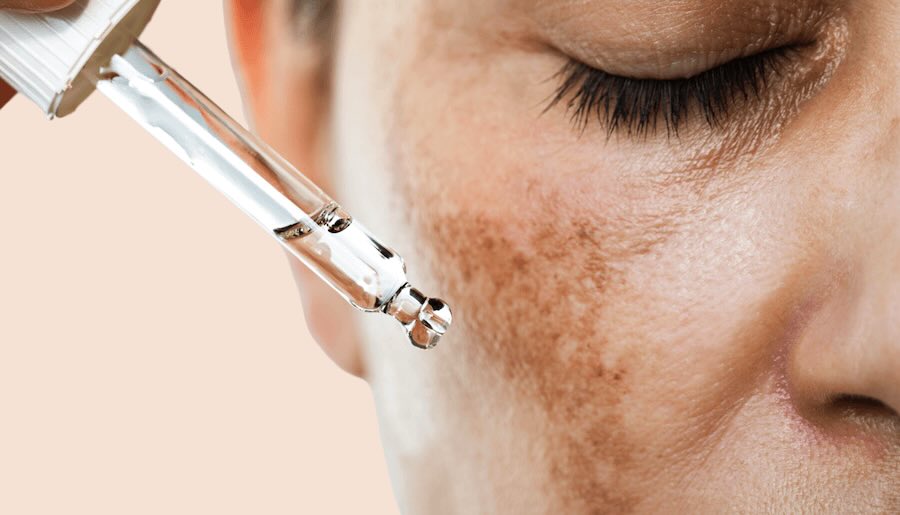
How to treat Melasma on the Face?
What is Melasma?
Also known as the mask of pregnancy, melasma is a skin condition characterized by the appearance of brown spots, usually on the face, which are pigmented.
Melasma results from excessive melanin production due to hyperactivity of melanocytes, the cells in the deep layer of the epidermis responsible for skin pigmentation.
These pigment spots mainly affect women, but some men can also develop melasma. Dark and matte skins are most affected.
Melasma most often appears on the face, mainly on the cheeks, forehead and upper lip, sometimes also on the temples and jawline.
These spots are often symmetrical and irregular in outline.
What causes melasma?
Hormonal factors
Hormonal factors play a central role in triggering melasma, particularly estrogen and progesterone, which have a direct effect on increasing melanin production.
For these reasons, pregnant women and those undergoing hormonal treatment are more prone to pigmentation spots.
These hormones, also responsible for the way melanin is distributed in the skin, make some areas darker than others.
Under the effect of the sun, these hormones can cause an increase in melanin production.
Repeated exposure to the sun
UV rays cause inflammation of the skin, which produces a barrier, melanin, to defend itself.
This production of melanin can lead to hyperpigmentation of the areas of the face most exposed to the sun.
Genetic predisposition
Some individuals have more active melanocytes than others and are more prone to developing melasma.
How can I prevent melasma?
To prevent the appearance of pigmentation spots, it’s important to adopt the right reflexes every day to combat the factors that trigger them.
- Protect yourself every morning, even in winter, against UVA and UVB rays with a protection factor of 30 or even 50.
- Avoid direct exposure to the sun by wearing a hat
- Avoid sun exposure during pregnancy
- Well manage hormonal factors by discussing oral contraceptives with your doctor if you think they may be contributing to the appearance of pigmentation spots
- Adopt a daily skin care routine
- Avoid irritating products that will make your skin more photosensitive
- Apply a Vitamin C-based cream like ZO Obagi’s every morning to protect against free radical damage.
How to treat melasma with Lasemd at Epilium & Skin?
At Epilium & Skin, we recommend Lasemd combined with a serum containing tranexamic acid for effective treatment of melasma.
This combination of fractional laser and cosmetic ampoules has proved its worth in the treatment of pigmentation spots.
This innovative medical laser from the Lutronic laboratory treats pigmentation spots using thulium technology.
The energy delivered by Lasemd creates micro-channels in the epidermis, enabling the active ingredients delivered to penetrate deep into the skin for maximum effectiveness.
Why combine Lasemd and tranexamic acid in the treatment of melasma?
Tranexamic acid is a highly effective molecule in the treatment of pigmentation marks such as melasma.
It acts by reducing melanin synthesis in melanocytes, the phenomenon responsible for hyperpigmentation.
Its anti-inflammatory effect prevents the skin from over-producing melanin when it feels attacked.
Tranexamic acid also minimizes the effects of UV rays on the skin, a phenomenon that promotes the appearance of melasma.
This acid is also very well tolerated by patients, making it possible to treat even those with sensitive skin.
What happens during a Lasemd session to treat pigmentation spots?
Before starting any treatment, you will receive a free consultation with one of our aesthetic physicians at Epilium & Skin. He or she will examine your skin and suggest the protocol best suited to your needs.
The session proceeds as follows
- Your skin is cleansed and an antiseptic solution is applied.
- The practitioner makes several passes with the Lasemd handpiece over the cheeks, forehead, eye contour or the whole face, according to your indications. The tip is fitted with magnetic rollers to ensure even distribution of laser energy. This is when the micro-channels are created, enabling the deep penetration of the active ingredients.
- The tranexamic acid-based serum is then applied to all treated facial areas.
- The session lasts about 30 minutes. A tingling sensation is felt during the session, but this is not painful.
After Lasemd treatment
You’ll leave with your ampoule of serum, which keeps for 15 days in the fridge.
For optimum results, we recommend that you continue to apply the serum twice a day in the days following the treatment.
Immediately after treatment, it is normal to feel warm for a few hours.
The skin may be red, as if sunburned. This redness disappears within 24 hours of the session.
Tiny points of impact may be visible for a week, but you can easily conceal them with make-up.
The skin may appear dry during this period while it regenerates.
Avoid exposure to the sun and protect yourself immediately with SPF 50.
What are the results of Lasemd melasma treatment?
Results are visible from the very first session. Your complexion is clearer and pigmentation spots are reduced.
Melasma cannot be treated in a single session, and we recommend a course of three treatments for best results.
Don’t hesitate to make an appointment for a free consultation with our aesthetic doctor.

